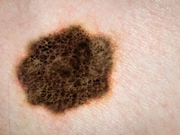Guidelines recommend surgical excision as primary treatment modality, emphasize individualized care
THURSDAY, Nov. 1, 2018 (HealthDay News) — New guidelines have been released for the treatment of primary cutaneous melanoma, according to a report from the American Academy of Dermatology published online Nov. 1 in the Journal of the American Academy of Dermatology.
Susan M. Swetter, M.D., from Stanford University Medical Center in California, and colleagues reviewed the evidence and made treatment recommendations for patients with primary cutaneous melanoma.
The researchers note that surgical excision is still the primary treatment modality for melanoma, while Mohs surgery or other forms of staged excision may be considered for certain melanomas. In limited cases in which surgery is not possible, topical therapy (including imiquimod) or traditional radiation may be considered; electronic surface brachytherapy is not recommended for melanoma treatment. The role of sentinel lymph node biopsy as a staging technique should be discussed and offered for cutaneous melanoma at least 1 mm in thickness or for thinner melanomas with adverse features. Discussion and decision making should be conducted on an individual basis. Evidence is lacking that pregnancy increases the risk for developing melanoma or affects prognosis. Management of melanoma in pregnancy should be individualized. Patients with a family history of melanoma should receive education and genetic risk counseling.
“The guidelines development process included patient advocate and community dermatologist input, and the resulting document emphasizes the importance of the doctor-patient dialogue in all aspects of melanoma management,” Hensin Tsao, M.D., Ph.D., co-chair of the guidelines work group, said in a statement.
Several authors disclosed ties to the biopharmaceutical industry.
Copyright © 2018 HealthDay. All rights reserved.








